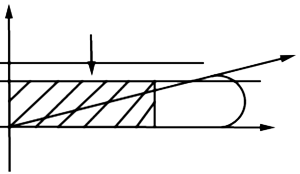Plasma-dielectric traveling wave antenna
DOI:
https://doi.org/10.3103/S0735272719110049Keywords:
plasma traveling wave antenna, linear antenna, limited plasma, directional pattern, microwave radiation, surface waveAbstract
The paper investigates the efficiency of transformation of traveling wave into radiation in longitudinally inhomogeneous plasma cylinder. The plasma is limited by a dielectric shell of finite thickness. The investigation involves the use of the method of spectral field expansion in terms of a set of functions including the surface and spatial waves of plasma cylinder with dielectric shell. A system of integro-differential equations for expansion coefficients has been obtained. These coefficients determine the amplitudes of transmitted, reflected, and scattered waves and also radiation patterns (RP). The system of equations is solved for the case of strong longitudinal variation of plasma density. The relationships of the transformation coefficients of surface wave energy as a function of the plasma density gradient, electrical length of section of plasma inhomogeneity, the electric radius of plasma cylinder, dielectric permittivity, and the thickness of dielectric were calculated. The fraction of surface wave energy that is transformed into radiation at acute angles can amount to 35%. The resultant narrow-beam RPs have only one lobe. The radiation maximum fits into an angle of several degrees with respect to the direction of surface wave propagation. With an increase of plasma density gradient, the lobe width is reduced, while its position shifts to 0°. The impact of dielectric properties on radiation characteristics has been also investigated.References
- Rayner, J.P.; Whichello, A.P.; Cheetman, A.D. “Physical characteristics of plasma antennas,” IEEE Trans. Plasma Science, v.32, n.1, p.269, 2004. DOI: https://doi.org/10.1109/tps.2004.826019.
- Istomin, E.N.; Karfidov, D.M.; Minaev, I.M.; Rukhadze, A.A.; Tarakanov, V.P.; Sergeichev, K.F.; Trefilov, A.Yu. “Plasma asymmetric dipole antenna excited by a surface wave,” Plasma Phys. Rep., v.32, n.5, p.388, 2006. DOI: https://doi.org/10.1134/S1063780X06050047.
- Derendyaev, D.N. “Radiation of a travelling-wave antenna in plasma in the whistler frequency band,” J. Commun. Technol. Electronics, v.62, n.4, p.337, 2017. DOI: https://doi.org/10.1134/S1064226917040040.
- Bogachev, N.N.; Bogdankevich, I.L.; Gusein-zade, N.G.; Rukhadze, A.A. “Surface wave and linear operating mode of a plasma antenna,” Plasma Phys. Rep., v.41, n.10, p.792, 2015. DOI: https://doi.org/10.1134/S1063780X15100037.
- Shevchenko, V.V. Smooth Transitions in Open Waveguides. Introduction to the Theory [in Russian].Moscow: Nauka, 1969.
- Kirichenko, Yu.V. “Radiation from a plasma layer with a strong longitudinal irregularity,” J. Commun. Technol. Electronics, v.62, n.12, p.1215, 2017. DOI: https://doi.org/10.1134/S1064226917110079.
- Kirichenko, Yu.V. “Cylindrical plasma antenna with large longitudinal density irregularity,” J. Commun. Technol. Electronics, v.63, n.5, p.438, 2018. DOI: https://doi.org/10.1134/S1064226918050042.
- Kirichenko, Yu.V.; Lonin, Yu.F.; Onishchenko, I.N. “Plasma travelling wave antenna,” Radioelectron. Commun. Syst., v.54, n.11, p.613, 2011. DOI: https://doi.org/10.3103/S0735272711110057.
- Kirichenko, Yu.V.; Lonin, Yu.F.; Onishchenko, I.N. “Microwave radiation of cylindrical plasma column,” Radioelectron. Commun. Syst., v.57, n.10, p.474, 2014. DOI: https://doi.org/10.3103/S0735272714100069.
- Walter, C.H. Traveling Wave Antennas.Dover Pub., 1970.
- Anderson, T. Plasma Antennas. Norwood Artech House, 2011.

Downloads
Published
2019-11-27
Issue
Section
Research Articles

